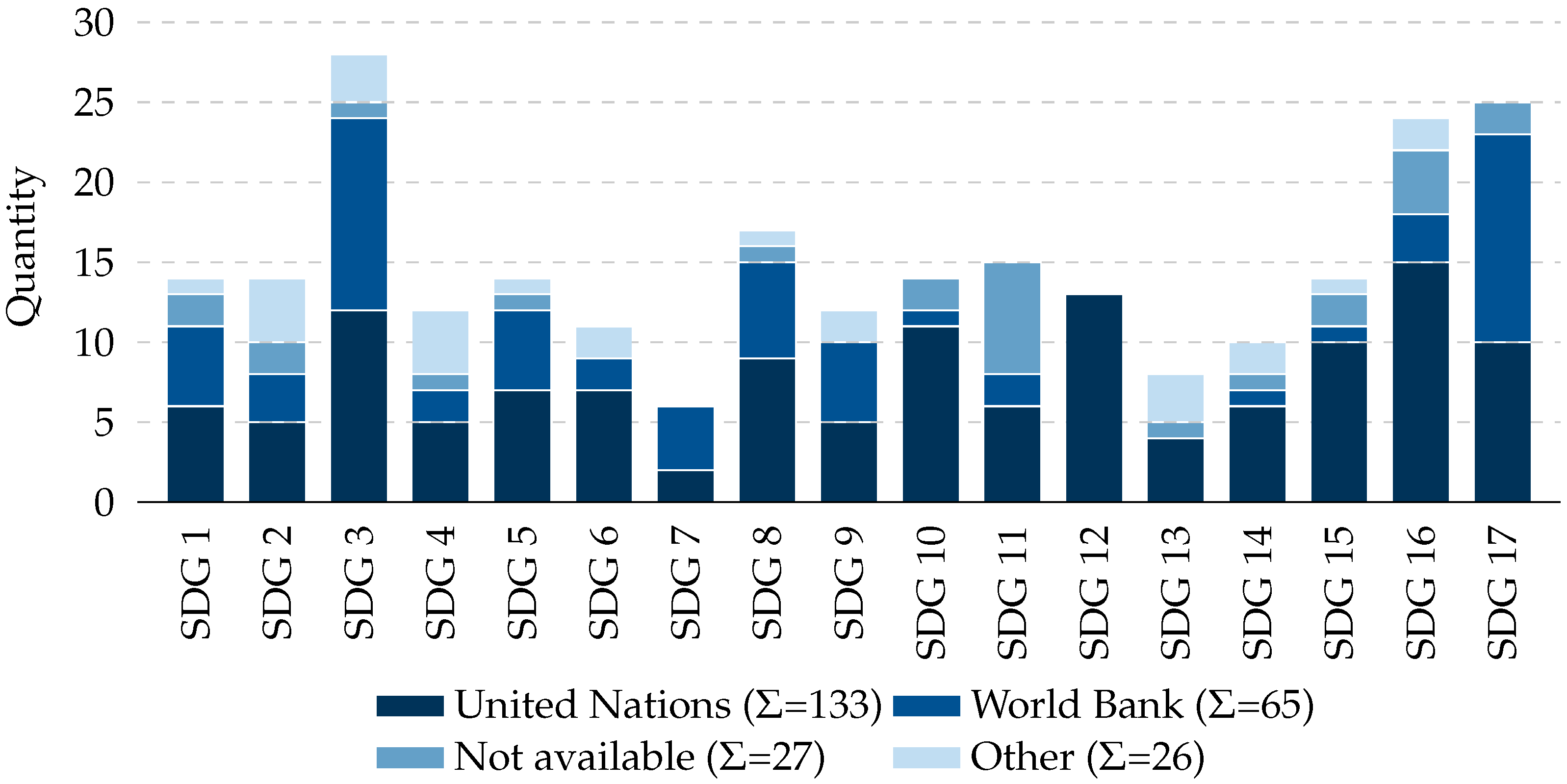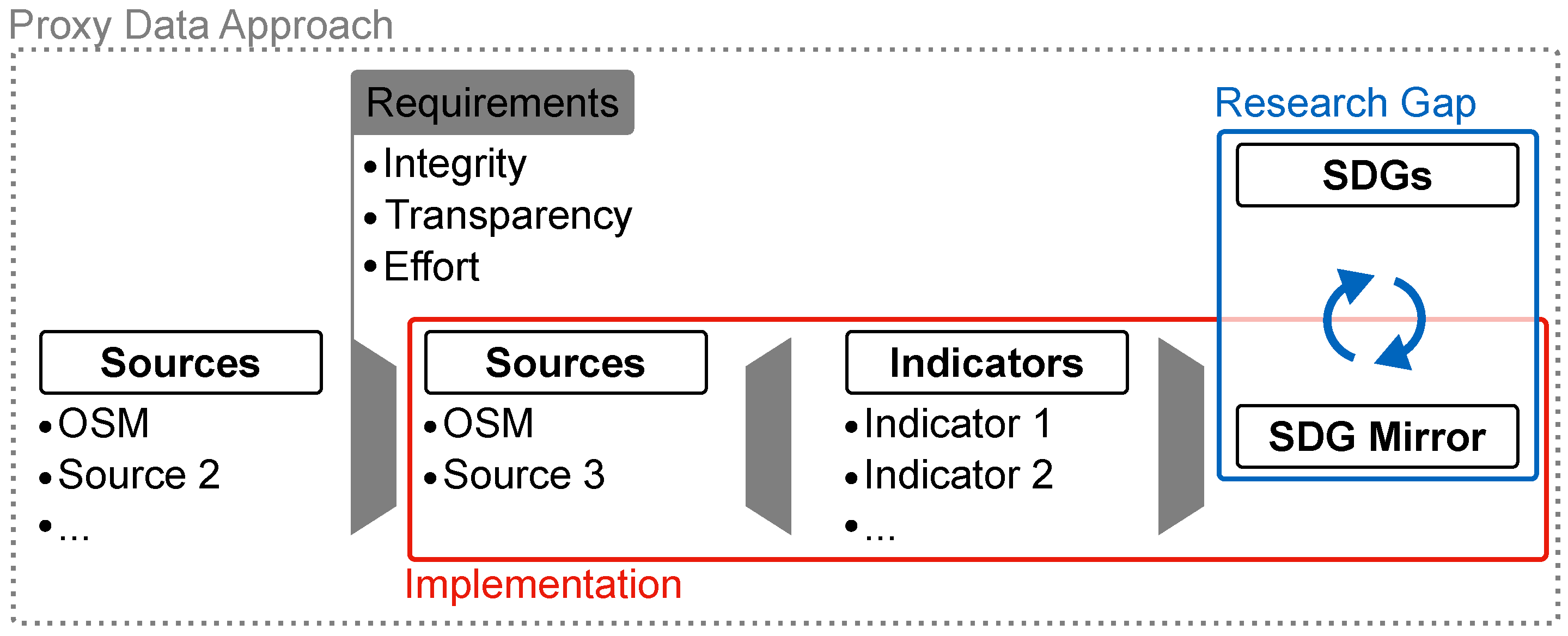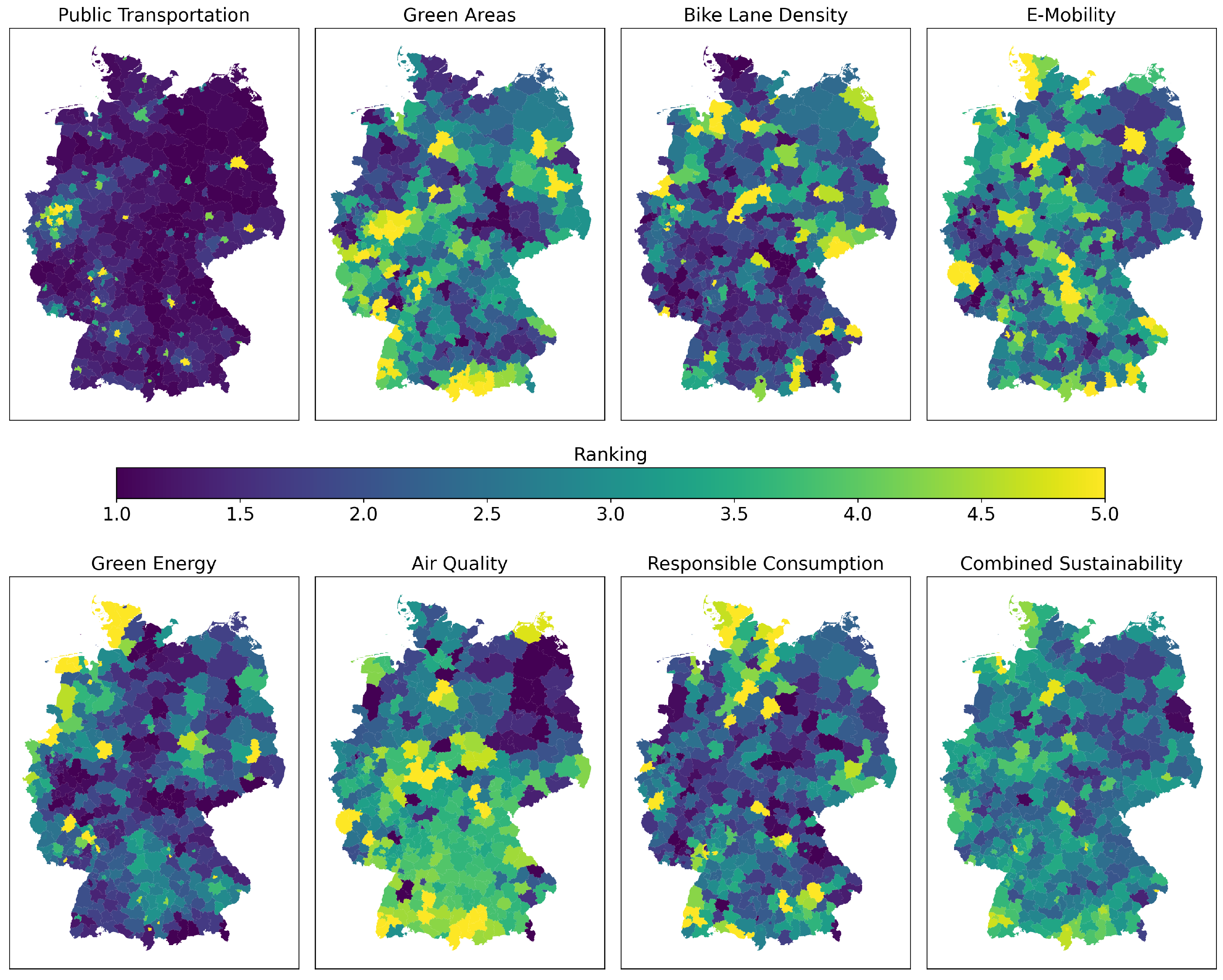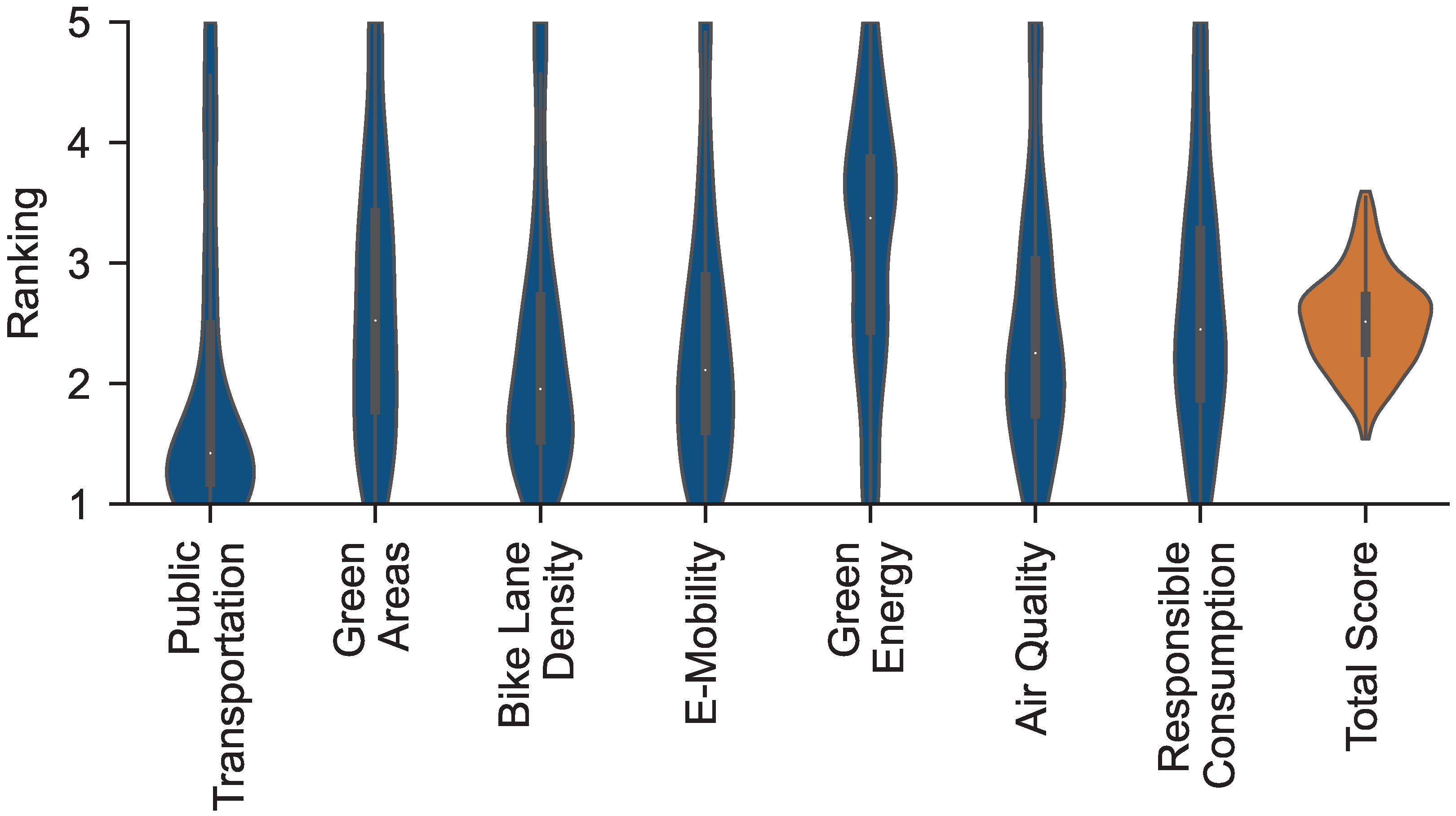How to Measure Sustainability? An Open-Data Approach
Abstract
:1. Introduction
2. State-of-the-Art
2.1. Global and Local Sustainability
2.2. Sustainability Assessment and Indicators
2.3. Sustainable Development Goals
2.4. Research Gap
3. The Sustainability Mirror
- Integrity: Data should be maintainable, traceable, and controllable by the community or trusted suppliers to guarantee integrity.
- Transparency: Data should be freely available to everyone and reflect local changes. Only under transparent conditions is the local initiative’s impact traceable for everyone.
- Effort: Data should be collected inside a bigger group of contributors (community) or acquired automatically not to presuppose substantial costs to keep data up to date. Therefore, data acquisition efforts should be low to guarantee a manageable and seamless integration.
3.1. Selection of Data Sources
- OpenStreetMap: We relied on the OSM platform due to its global importance for cartography and geographic data collection. Over the last decade, OSM has gained an increasing awareness, also for SDG data in developing regions, driven by initiatives such as the Humanitarian OpenStreetMap Team (HOT) or the American Red Cross (ARC) [36]. With over eight million members, OSM maintains data via the community and is, therefore, balanced over multiple members (↓ effort) [37]. All data are openly accessible (↑ transparency) and retrievable over multiple platforms (e.g., OverPass or Geofabrik). OSM ensures data integrity with active community members maintaining the dataset, but without strict data annotation rules (↖ integrity).
- Open Charge Map: The Open Charge Map (OCM) platform provides global vehicle charging station information and locations. The platforms’ data are open and freely accessible (↑ transparency). In comparison to other platforms, the OCM provides a high level of detail and live updates. The OCM is maintained by a community (↓ effort) consisting of “businesses, charities and developers” (↑ integrity) [38].
- Open Power System Data: The Open Power System Data (OPSD) collection mainly includes data collected by German and Swiss universities focusing on power systems (renewable and conventional power plants) and weather and household information in Central Europe [39]. The dataset is maintained by the aforementioned scientific contributors (↑ integrity) and updated by them yearly (↓ effort). As manuals and the dataset are offered freely, data transparency is a given (↑ transparency).
- IQAir: IQAir collects air pollution data, especially particulate matter (PM2.5) statistics, all over the globe. Data are mostly collected automatically in real-time (↓ effort) from ground-based stations backed by governmental and non-governmental providers (↑ integrity). Data access is provided via an API but requires an API-Key, and therefore, open access is limited (← transparency).
3.2. Derivation of Indicators
3.2.1. Public Transportation
3.2.2. Bike Lane Density
3.2.3. Green Areas
3.2.4. Sustainable Consumption
3.2.5. E-Mobility Infrastructure
3.2.6. Green Energy
3.2.7. Air Quality
4. Implementation
4.1. Public Transportation
4.2. Green Areas

4.3. Bike Lane Density

4.4. Responsible Consumption

4.5. E-Mobility Infrastructure

4.6. Renewable Power Plants

4.7. Air Quality
4.8. Overall Score
- 1: Very poor;
- 2: Poor;
- 3: Fair;
- 4: Very good;
- 5: Excellent.
5. Results and Discussion
5.1. Local Scale
- Comparable population and area (i.e., within 10%);
- Similar overall score;
- Within 100 to TUM and E.ON SE headquarters (Munich and Essen), respectively.
- Both cities have made efforts to improve their infrastructure (public transportation) and to make it greener (green areas and bike lane density). The same applies to lowering pollutant emissions. The Sustainability Mirror reflects these developments very well, which is why we assumed that it is a good proxy for overarching SDGs (Section 3.2), especially for a local resolution.
- The Sustainability Mirror can adequately represent developments in the ecological sustainability pillar, using green areas as proxy data.
- Neither Augsburg nor Bonn addressed e-mobility in their own reports. On the one hand, this could be due to the publication date, missing the recent uptake of electric mobility. On the other hand, as private companies often build and operate e-mobility infrastructure, it might be challenging to capture it in public reports.
- The cities’ economically sustainable development is hardly directly measurable. The mirror’s dimensions, responsible consumption, e-mobility infrastructure, and green energy hint at economic developments. However, we cannot clearly correlate these dimensions with the development described in the reports.
- Both reports give special attention to social sustainability aspects. Foremost, education, inclusiveness, and equality are essential targets for the cities’ development. None of these dimensions is currently reflected by the Sustainability Mirror and should be considered in future research.
- In an international energy market, energy production and consumption do not necessarily occur in the same place. As a consequence, the officially reported energy mix is an accounting figure, reflecting authorities’ and cities’ ownership or shares in renewable energy assets abroad or several hundred kilometers away, not directly matched with the physical energy consumption at the location. Within the Sustainability Mirror, we chose a different approach: the green energy index reflects the actual installed renewable capacity within the administrative boundary, underpinning the local physical match between demand and supply. This way, counties or cities could be motivated to install renewable energy sources instead of accounting for remote assets. A method, as proposed by Krapf et al. [79], that measures the installed photovoltaic capacity on building roofs could extend the index in the future. However, the method by Krapf et al. [79] cannot be scaled to larger regions yet, as required for the Sustainability Mirror.
5.2. National Scale
6. Summary and Conclusions
Supplementary Materials
Author Contributions
Funding
Institutional Review Board Statement
Informed Consent Statement
Data Availability Statement
Conflicts of Interest
References
- Brundtland, G.; Khalid, M.; Agnelli, S.; Al-Athel, S.; Chidzero, B.; Fadika, L.; Hauff, V.; Lang, I.; Shijun, M.; Morino de Botero, M.; et al. Our Common Future (’Brundtland report’); Oxford University Press: Oxford, UK, 1987. [Google Scholar]
- Transforming our World: The 2030 Agenda for Sustainable Development: A/RES/70/1. Available online: https://sdgs.un.org/2030agenda (accessed on 20 January 2023).
- United Nations Sustainable Development. United Nations Conference on Environment & Development: Agenda 21. Available online: https://sustainabledevelopment.un.org/content/documents/Agenda21.pdf (accessed on 30 January 2023).
- Wiedmann, T.; Allen, C. City footprints and SDGs provide untapped potential for assessing city sustainability. Nat. Commun. 2021, 12, 3758. [Google Scholar] [CrossRef] [PubMed]
- Mascarenhas, A.; Coelho, P.; Subtil, E.; Ramos, T.B. The role of common local indicators in regional sustainability assessment. Ecol. Indic. 2010, 10, 646–656. [Google Scholar] [CrossRef]
- Howard, J.; Wheeler, J. What community development and citizen participation should contribute to the new global framework for sustainable development. Community Dev. J. 2015, 50, 552–570. [Google Scholar] [CrossRef]
- Fraser, E.D.; Dougill, A.J.; Mabee, W.E.; Reed, M.; McAlpine, P. Bottom up and top down: Analysis of participatory processes for sustainability indicator identification as a pathway to community empowerment and sustainable environmental management. J. Environ. Manag. 2006, 78, 114–127. [Google Scholar] [CrossRef]
- Moallemi, E.A.; Bertone, E.; Eker, S.; Gao, L.; Szetey, K.; Taylor, N.; Bryan, B.A. A review of systems modelling for local sustainability. Environ. Res. Lett. 2021, 16, 113004. [Google Scholar] [CrossRef]
- Gonzalez Morales, L.; Hsu, Y.C.; Poole, J.; Rae, B.; Rutherford, I. A World that Counts; United Nations: New York, NY, USA, 2014.
- Perez, R.; Arturo, J.; Emilsson, C.; Ubaldi, B. Public Governance Policy Papers: Open, Useful and Re-usable data (OURdata) Index: OECD Policy Papers on Public Governance 2019. 2020. Available online: https://www.oecd.org/gov/digital-government/policy-paper-ourdata-index-2019.htm (accessed on 30 January 2023).
- Independent Expert Advisory Group. A World a that Counts: Mobilising the Data Revolution for Sustainable Development. 2014. Available online: https://www.undatarevolution.org/wp-content/uploads/2014/11/A-World-That-Counts.pdf (accessed on 30 January 2023).
- Choi, J.; Hwang, M.; Kim, G.; Seong, J.; Ahn, J. Supporting the measurement of the United Nations’ sustainable development goal 11 through the use of national urban information systems and open geospatial technologies: A case study of south Korea. Open Geospat. Data Softw. Stand. 2016, 1, 4. [Google Scholar] [CrossRef]
- Ness, B.; Urbel-Piirsalu, E.; Anderberg, S.; Olsson, L. Categorising tools for sustainability assessment. Ecol. Econ. 2007, 60, 498–508. [Google Scholar] [CrossRef]
- Hák, T.; Janoušková, S.; Moldan, B. Sustainable Development Goals: A need for relevant indicators. Ecol. Indic. 2016, 60, 565–573. [Google Scholar] [CrossRef]
- Singh, G.G.; Cisneros-Montemayor, A.M.; Swartz, W.; Cheung, W.; Guy, J.A.; Kenny, T.A.; McOwen, C.J.; Asch, R.; Geffert, J.L.; Wabnitz, C.C.; et al. A rapid assessment of co-benefits and trade-offs among Sustainable Development Goals. Mar. Policy 2018, 93, 223–231. [Google Scholar] [CrossRef]
- Wackernagel, M.; Hanscom, L.; Lin, D. Making the Sustainable Development Goals Consistent with Sustainability. Front. Energy Res. 2017, 5, 18. [Google Scholar] [CrossRef] [Green Version]
- Ritchie, H.; Roser, M.; Mispy, J.; Ortiz-Ospina, E. Measuring progress towards the Sustainable Development Goals—SDG Tracker. 2018. Available online: https://sdg-tracker.org (accessed on 23 January 2023).
- Assmann, D.; Honold, J.; Grabow, B.; Roose, J. Bertelsmann Stiftung.; Bundesinstitut für Bau-, Stadt- und Raumforschung.; Deutscher Landkreistag.; Deutscher Städtetag.; Deutscher Städte- und Gemeindebund.; Deutsches Institut für Urbanistik.; ICLEI European Secretariat.; Rat der Gemeinden und Regionen Europas / Deutsche Sektion. SDG-Indikatoren für Kommunen. Available online: https://www.rgre.de/rgre (accessed on 30 January 2023).
- Sachs, J.; Kroll, C.; Lafortune, G.; Fuller, G.; Woelm, F. Sustainable Development Report 2021; Cambridge University Press: Cambridge, UK, 2021. [Google Scholar]
- Statistics Division United Nations. SDG Indicators—SDG Indicators. 2022. Available online: https://unstats.un.org/sdgs/dataContacts/ (accessed on 30 January 2023).
- Spangenberg, J.H. Hot Air or Comprehensive Progress? A Critical Assessment of the SDGs. Sustain. Dev. 2017, 25, 311–321. [Google Scholar] [CrossRef]
- Gusmão Caiado, R.G.; Leal Filho, W.; Quelhas, O.L.G.; Luiz de Mattos Nascimento, D.; Ávila, L.V. A literature-based review on potentials and constraints in the implementation of the sustainable development goals. J. Clean. Prod. 2018, 198, 1276–1288. [Google Scholar] [CrossRef]
- McGuinn, J.; Fries-Tersch, E.; Jones, M.; Crepaldi, C.; Masso, M.; Lodovici, M.S.; Drufuca, S.; Gancheva, M.; Geny, B. Social Sustainability—Concepts and Benchmarks. 2020. Available online: https://www.europarl.europa.eu/RegData/etudes/STUD/2020/648782/IPOL_STU(2020)648782_EN.pdf (accessed on 31 January 2023).
- Nilsson, M.; Griggs, D.; Visbeck, M. Policy: Map the interactions between Sustainable Development Goals. Nature 2016, 534, 320–322. [Google Scholar] [CrossRef]
- Robert, K.W.; Parris, T.M.; Leiserowitz, A.A. What is Sustainable Development? Goals, Indicators, Values, and Practice. Environ. Sci. Policy Sustain. Dev. 2005, 47, 8–21. [Google Scholar] [CrossRef]
- Fraisl, D.; Campbell, J.; See, L.; Wehn, U.; Wardlaw, J.; Gold, M.; Moorthy, I.; Arias, R.; Piera, J.; Oliver, J.L.; et al. Mapping citizen science contributions to the UN sustainable development goals. Sustain. Sci. 2020, 15, 1735–1751. [Google Scholar] [CrossRef]
- Wolff, S.; Brönner, M.; Held, M.; Lienkamp, M. Transforming automotive companies into sustainability leaders: A concept for managing current challenges. J. Clean. Prod. 2020, 276, 124179. [Google Scholar] [CrossRef]
- Engert, S.; Baumgartner, R.J. Corporate sustainability strategy—Bridging the gap between formulation and implementation. J. Clean. Prod. 2016, 113, 822–834. [Google Scholar] [CrossRef]
- Kiesnere, A.L.; Baumgartner, R.J. Sustainability management emergence and integration on different management levels in smaller large-sized companies in Austria. Corp. Soc. Responsib. Environ. Manag. 2019, 26, 1607–1626. [Google Scholar] [CrossRef]
- Sukitsch, M.; Engert, S.; Baumgartner, R. The Implementation of Corporate Sustainability in the European Automotive Industry: An Analysis of Sustainability Reports. Sustainability 2015, 7, 11504–11531. [Google Scholar] [CrossRef]
- Dickinson, J.L.; Shirk, J.; Bonter, D.; Bonney, R.; Crain, R.L.; Martin, J.; Phillips, T.; Purcell, K. The current state of citizen science as a tool for ecological research and public engagement. Front. Ecol. Environ. 2012, 10, 291–297. [Google Scholar] [CrossRef] [Green Version]
- United Nations. The Sustainable Development Goals Report 2021; United Nations: New York, NY, USA, 2021.
- Zuiderwijk, A.; Hinnant, C.C. Open data policy-making: A review of the state-of-the-art and an emerging research agenda. Inf. Polity 2019, 24, 117–129. [Google Scholar] [CrossRef]
- Kuemmerle, T.; Erb, K.; Meyfroidt, P.; Müller, D.; Verburg, P.H.; Estel, S.; Haberl, H.; Hostert, P.; Jepsen, M.R.; Kastner, T.; et al. Challenges and opportunities in mapping land use intensity globally. Curr. Opin. Environ. Sustain. 2013, 5, 484–493. [Google Scholar] [CrossRef] [PubMed]
- Saah, D.; Tenneson, K.; Matin, M.; Uddin, K.; Cutter, P.; Poortinga, A.; Nguyen, Q.H.; Patterson, M.; Johnson, G.; Markert, K.; et al. Land cover mapping in data scarce environments: Challenges and opportunities. Front. Environ. Sci. 2019, 7, 150. [Google Scholar] [CrossRef]
- Herfort, B.; Lautenbach, S.; Porto de Albuquerque, J.; Anderson, J.; Zipf, A. The evolution of humanitarian mapping within the OpenStreetMap community. Sci. Rep. 2021, 11, 3037. [Google Scholar] [CrossRef] [PubMed]
- OpenStreetMap. 2022. Available online: https://www.openstreetmap.org/ (accessed on 31 January 2023).
- Lilley, S.; Kotter, R.; Evatt, N. A Review of Electric Vehicle Charge Point Map Websites in the NSR: Interim Report. 2013. Available online: http://e-mobility-nsr.eu/fileadmin/userupload/downloads/info-pool/ReviewofNSRchargepointmapsinterimreportJune2013final.pdf (accessed on 30 January 2022).
- Wiese, F.; Schlecht, I.; Bunke, W.D.; Gerbaulet, C.; Hirth, L.; Jahn, M.; Kunz, F.; Lorenz, C.; Mühlenpfordt, J.; Reimann, J.; et al. Open Power System Data—Frictionless data for electricity system modelling. Appl. Energy 2019, 236, 401–409. [Google Scholar] [CrossRef]
- Klopp, J.M.; Petretta, D.L. The urban sustainable development goal: Indicators, complexity and the politics of measuring cities. Cities 2017, 63, 92–97. [Google Scholar] [CrossRef]
- Williams, S.; White, A.; Waiganjo, P.; Orwa, D.; Klopp, J. The digital matatu project: Using cell phones to create an open source data for Nairobi’s semi-formal bus system. J. Transp. Geogr. 2015, 49, 39–51. [Google Scholar] [CrossRef]
- Westfall, M.S.; De Villa, V.A. Urban Indicators for Managing Cities; Asian Development Bank: Mandaluyong, Philippines, 2001. [Google Scholar]
- Cycling Delivers on the Global Goals. 2016. Available online: https://ecf.com/sites/ecf.com/files/The%20Global%20Goals_internet.pdf (accessed on 31 January 2023).
- Horton, D. Environmentalism and the bicycle. Environ. Politics 2006, 15, 41–58. [Google Scholar] [CrossRef]
- De Nazelle, A.; Nieuwenhuijsen, M.J.; Antó, J.M.; Brauer, M.; Briggs, D.; Braun-Fahrlander, C.; Cavill, N.; Cooper, A.R.; Desqueyroux, H.; Fruin, S.; et al. Improving health through policies that promote active travel: A review of evidence to support integrated health impact assessment. Environ. Int. 2011, 37, 766–777. [Google Scholar] [CrossRef]
- Pucher, J.; Buehler, R. Making cycling irresistible: Lessons from the Netherlands, Denmark and Germany. Transp. Rev. 2008, 28, 495–528. [Google Scholar] [CrossRef]
- Winters, M.; Brauer, M.; Setton, E.M.; Teschke, K. Mapping bikeability: A spatial tool to support sustainable travel. Environ. Plan. B Plan. Des. 2013, 40, 865–883. [Google Scholar] [CrossRef]
- Krenn, P.J.; Oja, P.; Titze, S. Development of a bikeability index to assess the bicycle-friendliness of urban environments. Open J. Civ. Eng. 2015, 5, 451. [Google Scholar] [CrossRef]
- Schmid-Querg, J.; Keler, A.; Grigoropoulos, G. The Munich Bikeability Index: A practical approach for measuring urban bikeability. Sustainability 2021, 13, 428. [Google Scholar] [CrossRef]
- Hardinghaus, M.; Nieland, S.; Lehne, M.; Weschke, J. More than Bike Lanes—A Multifactorial Index of Urban Bikeability. Sustainability 2021, 13, 11584. [Google Scholar] [CrossRef]
- Kuklina, V.; Sizov, O.; Fedorov, R. Green spaces as an indicator of urban sustainability in the Arctic cities: Case of Nadym. Polar Sci. 2021, 29, 100672. [Google Scholar] [CrossRef]
- Heikinheimo, V.; Tenkanen, H.; Bergroth, C.; Järv, O.; Hiippala, T.; Toivonen, T. Understanding the use of urban green spaces from user-generated geographic information. Landsc. Urban Plan. 2020, 201, 103845. [Google Scholar] [CrossRef]
- Feltynowski, M.; Kronenberg, J.; Bergier, T.; Kabisch, N.; Łaszkiewicz, E.; Strohbach, M.W. Challenges of urban green space management in the face of using inadequate data. Urban For. Urban Green. 2018, 31, 56–66. [Google Scholar] [CrossRef]
- Wysmułek, J.; Hełdak, M.; Kucher, A. The analysis of green areas’ accessibility in comparison with statistical data in Poland. Int. J. Environ. Res. Public Health 2020, 17, 4492. [Google Scholar] [CrossRef]
- Becchetti, L.; Fiaschetti, M.; Salustri, F. Let us buy sustainable! The impact of cash mobs on sustainable consumption: Experimental results. J. Clean. Prod. 2021, 317, 128419. [Google Scholar] [CrossRef]
- Song, L.; Lim, Y.; Chang, P.; Guo, Y.; Zhang, M.; Wang, X.; Yu, X.; Lehto, M.R.; Cai, H. Ecolabel’s role in informing sustainable consumption: A naturalistic decision making study using eye tracking glasses. J. Clean. Prod. 2019, 218, 685–695. [Google Scholar] [CrossRef]
- Fuentes, C. Smart consumers come undone: Breakdowns in the process of digital agencing. J. Mark. Manag. 2019, 35, 1542–1562. [Google Scholar] [CrossRef]
- Dyen, M.; Sirieix, L.; Costa, S.; Depezay, L.; Castagna, E. Exploring the dynamics of food routines: A practice-based study to understand households’ daily life. Eur. J. Mark. 2018, 52, 2544–2556. [Google Scholar] [CrossRef]
- Fuentes, C.; Cegrell, O.; Vesterinen, J. Digitally enabling sustainable food shopping: App glitches, practice conflicts, and digital failure. J. Retail. Consum. Serv. 2021, 61, 102546. [Google Scholar] [CrossRef]
- Hargreaves, T.; Wilson, C.; Hauxwell-Baldwin, R. Learning to live in a smart home. Build. Res. Inf. 2018, 46, 127–139. [Google Scholar] [CrossRef]
- Flammini, M.G.; Prettico, G.; Julea, A.; Fulli, G.; Mazza, A.; Chicco, G. Statistical characterisation of the real transaction data gathered from electric vehicle charging stations. Electr. Power Syst. Res. 2019, 166, 136–150. [Google Scholar] [CrossRef]
- Nicholas, M.; Hall, D.; Lutsey, N. Quantifying the electric vehicle charging infrastructure gap across US markets. Int. Counc. Clean Transp. 2019, 1–39. Available online: https://theicct.org/publication/quantifying-the-electric-vehicle-charging-infrastructure-gap-across-u-s-markets/ (accessed on 30 January 2023).
- Lee, J.; Park, G.L.; Han, Y.; Yoo, S. Big data analysis for an electric vehicle charging infrastructure using open data and software. In Proceedings of the Eighth International Conference on Future Energy Systems, Hong Kong, China, 16–19 May 2017; pp. 252–253. [Google Scholar]
- Falchetta, G.; Noussan, M. Electric vehicle charging network in Europe: An accessibility and deployment trends analysis. Transp. Res. Part D Transp. Environ. 2021, 94, 102813. [Google Scholar] [CrossRef]
- ACEA. European Automobile Manufacturers’ Association, Making the Transition to Zero-Emission Mobility—2020 Progress Report 2020. 2020. Available online: https://www.acea.auto/publication/making-the-transition-to-zero-emission-mobility-2020-progress-report (accessed on 30 January 2023).
- Conti, J.; Holtberg, P.; Diefenderfer, J.; LaRose, A.; Turnure, J.T.; Westfall, L. International Energy Outlook 2016 with Projections to 2040; Technical Report; USDOE Energy Information Administration (EIA): Washington, DC, USA, 2016.
- Ozkan, M.B.; Küçük, D.; Buhan, S.; Demirci, T.; Karagoz, P. Large-scale renewable energy monitoring and forecast based on intelligent data analysis. In Handbook of Research on Smart Computing for Renewable Energy and Agro-Engineering; IGI Global: Hershey, PA, USA, 2020; pp. 53–77. [Google Scholar]
- Trumpy, E.; Bertani, R.; Manzella, A.; Sander, M. The web-oriented framework of the world geothermal production database: A business intelligence platform for wide data distribution and analysis. Renew. Energy 2015, 74, 379–389. [Google Scholar] [CrossRef]
- Punys, P.; Baublys, R.; Kasiulis, E.; Vaisvila, A.; Pelikan, B.; Steller, J. Assessment of renewable electricity generation by pumped storage power plants in EU Member States. Renew. Sustain. Energy Rev. 2013, 26, 190–200. [Google Scholar] [CrossRef]
- Kelsey, N.; Meckling, J. Who wins in renewable energy? Evidence from Europe and the United States. Energy Res. Soc. Sci. 2018, 37, 65–73. [Google Scholar] [CrossRef]
- Tan, X.; Han, L.; Zhang, X.; Zhou, W.; Li, W.; Qian, Y. A review of current air quality indexes and improvements under the multi-contaminant air pollution exposure. J. Environ. Manag. 2021, 279, 111681. [Google Scholar] [CrossRef]
- Benammar, M.; Abdaoui, A.; Ahmad, S.H.; Touati, F.; Kadri, A. A modular IoT platform for real-time indoor air quality monitoring. Sensors 2018, 18, 581. [Google Scholar] [CrossRef]
- Büke, T.; Köne, A.Ç. Assessing air quality in Turkey: A proposed, air quality index. Sustainability 2016, 8, 73. [Google Scholar] [CrossRef]
- World Air Quality Report: Region & City PM2.5 Ranking. 2020. Available online: https://www.iqair.com/world-most-polluted-cities/world-air-quality-report-2020-en.pdf (accessed on 31 January 2023).
- European Commission. Statistical Office of the European Union. In Statistical Regions in the European Union and Partner Countries: NUTS and Statistical Regions 2021: 2022 Edition; Publications Office: Luxembourg, 2022. [Google Scholar]
- City of Augsburg. Zukunftsleitlinien für Augsburg [Future guidelines for Augsburg]; Technical Report; City of Augsburg: Augsburg, Germany, 2015. [Google Scholar]
- Stamm, N. Auswertung der Nachhaltigkeitseinschätzungen für Beschlussvorlagen des Augsburger Stadtrats [Evaluation of Sustainability Assessments for Draft Resolutions of the Augsburg City Council]; Technical Report; City of Augsburg: Augsburg, Germany, 2020. [Google Scholar]
- Bonn City Hall. Nachhaltigkeitsbericht der Stadt Bonn 2016–2018 [Sustainability Report of the City of Bonn 2016-2018]; Technical Report; Bonn City Hall: Bonn, Germany, 2018. [Google Scholar]
- Krapf, S.; Kemmerzell, N.; Uddin, S.K.H.; Vázquez, M.H.; Netzler, F.; Lienkamp, M. Towards Scalable Economic Photovoltaic Potential Analysis Using Aerial Images and Deep Learning. Energies 2021, 14, 3800. [Google Scholar] [CrossRef]








| Data Source | Integrity | Transparency | Effort |
|---|---|---|---|
| OSM |  |  |  |
| OCM |  |  |  |
| OPSD |  |  |  |
| IQAir |  |  |  |
 low to
low to  high integrity |
high integrity |  low to
low to  high transparency |
high transparency |  high to
high to  less effort.
less effort.| Indicator | Data Source | SDG | Economic | Environmental | Social |
|---|---|---|---|---|---|
| Public Transportation | OSM | 1, 9, 10, 11, 13 |  |  |  |
| Bike Lane Density | 3, 9, 11, 13 |  |  |  | |
| Green Areas | 3, 11, 13, 15 |  |  |  | |
| Sustainable Consumption | 8, 12 |  |  |  | |
| E-Mobility Infrastructure | OCM | 7, 9, 11, 12 |  |  |  |
| Green Energy | OPSD | 7, 8, 12 |  |  |  |
| Air Quality | IQAir | 3, 11, 13, 15 |  |  |  |
 no relation |
no relation |  indirect relation |
indirect relation |  direct relation.
direct relation.Disclaimer/Publisher’s Note: The statements, opinions and data contained in all publications are solely those of the individual author(s) and contributor(s) and not of MDPI and/or the editor(s). MDPI and/or the editor(s) disclaim responsibility for any injury to people or property resulting from any ideas, methods, instructions or products referred to in the content. |
© 2023 by the authors. Licensee MDPI, Basel, Switzerland. This article is an open access article distributed under the terms and conditions of the Creative Commons Attribution (CC BY) license (https://creativecommons.org/licenses/by/4.0/).
Share and Cite
Ziegler, D.; Wolff, S.; Agu, A.-B.; Cortiana, G.; Umair, M.; Durfort, F.d.; Neumann, E.; Walther, G.; Kristiansen, J.; Lienkamp, M. How to Measure Sustainability? An Open-Data Approach. Sustainability 2023, 15, 3203. https://doi.org/10.3390/su15043203
Ziegler D, Wolff S, Agu A-B, Cortiana G, Umair M, Durfort Fd, Neumann E, Walther G, Kristiansen J, Lienkamp M. How to Measure Sustainability? An Open-Data Approach. Sustainability. 2023; 15(4):3203. https://doi.org/10.3390/su15043203
Chicago/Turabian StyleZiegler, David, Sebastian Wolff, Ana-Beatrice Agu, Giorgio Cortiana, Muhammad Umair, Flore de Durfort, Esther Neumann, Georg Walther, Jakob Kristiansen, and Markus Lienkamp. 2023. "How to Measure Sustainability? An Open-Data Approach" Sustainability 15, no. 4: 3203. https://doi.org/10.3390/su15043203






